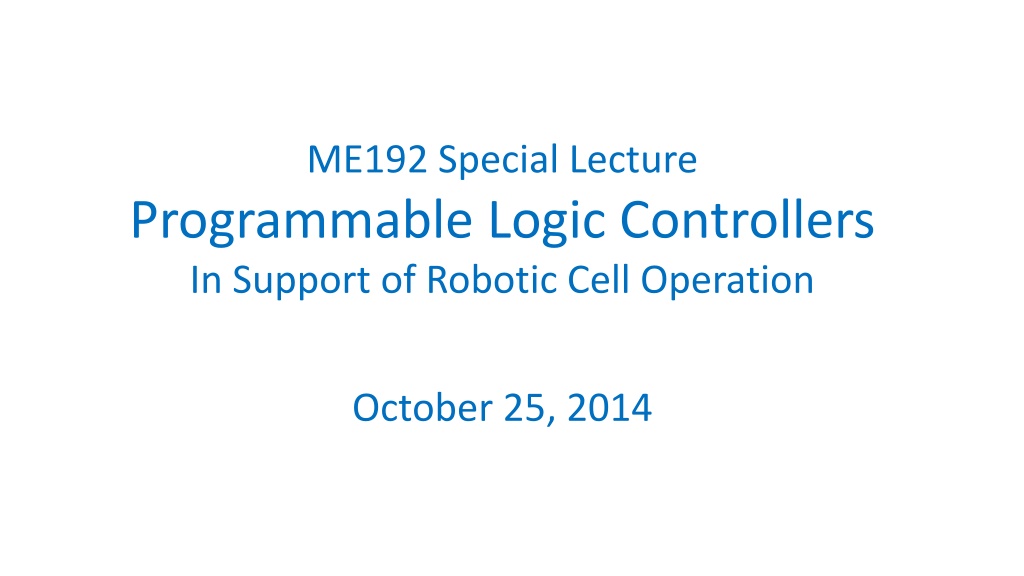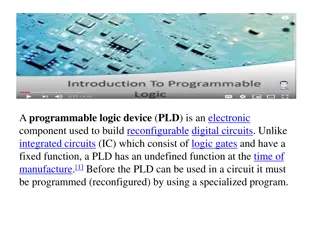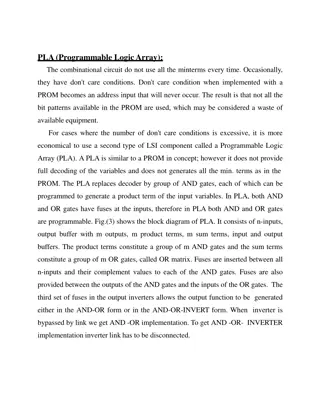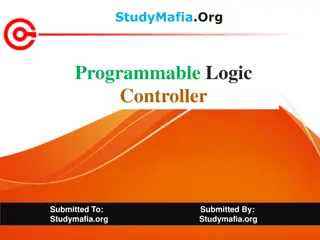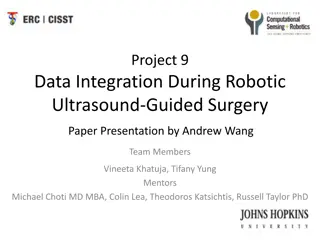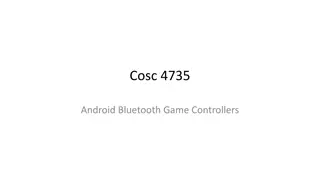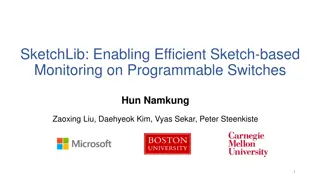Understanding Programmable Logic Controllers (PLCs) in Robotic Cell Operations
Programmable Logic Controllers (PLCs) are versatile devices used in various industries for automation and control processes. This article explores the functionality and applications of PLCs in supporting robotic cell operations, emphasizing their role in conveyor control, multi-robot workstations, and industrial robot applications. It delves into the basic constructs, processing, and benefits of using PLCs in manufacturing environments, showcasing their essential role in optimizing production efficiency and flexibility.
Download Presentation

Please find below an Image/Link to download the presentation.
The content on the website is provided AS IS for your information and personal use only. It may not be sold, licensed, or shared on other websites without obtaining consent from the author. Download presentation by click this link. If you encounter any issues during the download, it is possible that the publisher has removed the file from their server.
E N D
Presentation Transcript
ME192 Special Lecture Programmable Logic Controllers In Support of Robotic Cell Operation October 25, 2014
Programmable Logic Controllers A PLC is a general purpose device that uses a programming module to continuously monitor the changes in the input status and updates the setting of the output relays and actuators. PLCs are packed with a variety of opto-isolated IO ports or modules, easy to use gate logic (called ladder logic) programming system, timers, counters, DAC-ADC converters, and communication ports. Other options and modules are added provide specific needed functionality and adaptability. PLCs and interconnected devices normally run on 24 volt DC power. External relays are necessarily added to handle voltage differences.
PLC Applications Widely used. More than a million PLC units from one US manufacturer alone are in use world-wide. PLCs are found in control enclosures for elevators, bottling, bakeries, assembly lines, food processing plants, steel mills, roller coasters, oil refineries, or in any places that flow materials through process steps. Just about all powered conveyor uses a PLC for control. A PLC(s) handle material flow for multi-robot workstations. In a robot centered manufacturing cell, a PLC is used to move the workpiece into and out of the cell and the robot moves the workpiece between process machines.
Use of a PLC in industrial robot application Robots do not travel. So parts need to be brought to the robot by a conveyor. PLCs are almost always used for conveyor control. A robot can control an immediate vicinity of a station, especially the robot is capable of multi-tasking as in the case of Adept robots. A PLC system enables decoupling robots in multi-station processes. Avoid signal interchange and hand-off of workpiece between robots. Along with robot vision, a well designed PLC controlled conveyor system supports the desirable mode of line operation: Asynchronous part arrival, random orientation of parts, Mixed part flow, flexible routing, non-batching, Use of belt conveyor without part fixture or carrier.
Basic Construct and Processing Basic Construct Compact vs. Modular. A compact PLC will have two sides on top the input ports and the output ports. A modular PLC will have minimally one input and one output module. The port counts are 8/16/32. The output ports are an open collector type meaning that a pull up voltage must be provided to the external relays. A 24 volt power supply often available from a PLC. 100 mA limits are typically set to sink power on each output port. Program logic Low level ladder logic or its mnemonic code. Higher level codes will still generate ladder logic equivalent (e.g., mnemonics), much like CNC software is used to generate a G code for machining. A PLC essentially replaces a microprocessor with external signal converters and timer circuits.
More on IO Ports and CPU Processing Operation The ports are opto-isolated for any discrepancy between the PLC operating voltage and those of external devices. The output ports support both NPN (current sinking) and PNP (current sourcing) external devices such as pneumatic actuators directly or via relays or relay boards. Program Logic (Ladder) Continuous scanning of program lines (rungs). In each scan cycle, the outputs (relays or coils) for the rung is energized if the inputs (switches) line. The outputs may be external or internal. The scan cycle time is typically in a millisecond range. The PLC logic can be programmed into a microprocessor or built into a circuit using standard gate logic ICs, RC or oscillator timers, and counter circuits. To reduce the chip count by a factor of 2 to 3, the gate logic may be programmed into a PAL, PLA or GAL chip.
Inputs and Outputs Inputs (Switches) All external 0-1 inputs are considered momentary and are registered at the beginning of a scan cycle. Types - Normally Open, Normally Closed, Rising Edge, and Falling Edge. The R.E. and F.E. switch types very momentary and may be substituted with a NO or a NC switch with an internal switch over two scan cycles. Thus, a PLC does not have to have provisions for RE and FE switches. Outputs (Coils) - External relay signals (pull down) and internal transient dummy outputs, timer and counter outputs. Types - Momentary (ON while Input is true .), SET/RESET (Latch/Unlatch) The Set/Reset outputs can be substituted with a momentary type using a retentive memory logic circuit. The external outputs are for turning on relays for motor starters, pneumatic valves for air cylinders, and hard-wired flag signals.
Scanning cycle A PLC works much like a gate logic IC which completes its circuit propagation by clock signal. PLC has a scan cycle time in which all rungs are scanned sequentially to see if the input conditions are met. At the end of the scan, all outputs are updated, followed by input read. Retentive memory circuit The scan cycle enables a PLC acting like a flip-flop IC which retains the previous state. With that, SET/RESET can be substituted with retentive memory circuit. Also, Rising/Falling edge function can be substituted.
Timers and Counters Timers and Counters Timers are driven by internal clock. Whereas, counters are driven by external event including encoder inputs. Both have limits set and are reset when the limits are reached. The timer output ( time s up ) may be up for one scan cycle only. If so, the status must be saved in a memory. A timer is driven by its input condition, so the input condition must stay true while the timer runs. If timers and counters are not used, there is no real reason to use a PLC as the whole program logic can be set up on gate logic ICs or a few PLA chips.
Communication Network Hardwire 3-4 wire 0-1 flag line between devices including a common return wire that may be just as effective as a DeviceNet if there are only a few stations. DeviceNet (4 wire - two signal lines and two 24V lines). Required if pneumatic control devices uses DeviceNet. Biggest advantage The wire count is drastically reduced in a multi-station application. Ethernet For communication with PC and with other PLCs. ControlNet For remote system monitoring and control. Via a single coaxial cable.
PLC Peripherals Output devices or modules Relays or relay boards that give both NO and NC outputs. Pneumatic solenoid valves or a block of valves that control linear actuators are actuated by the relays. Analog signal output via an analog output module. Input devices or modules Analog input converters (ADC) Encoder inputs or other high speed pulse counters Opto-isolator boards for additional protection.
Scan Time Enabled Function Substitutions A. Retentive Memory Set Reset Given a momentary switch X and a momentary output Y, if X becomes true once, Y will turn on and stay on indefinitely. X OR Y Y (If X is On or Y is On, then turn on Y.) This is the same result as X SET Y (If X is On, then turn on Y until Reset.) B. Rising Edge Falling Edge The same condition can be created on a gate logic IC. With X (a momentary input), X1 (X s clone), and Y (a latch output) all initially set to zero, a sequential execution of the two rungs in a scan cycle. X and Not(X1) SET Y X X1 This is the same result as R.E. (X) SET Y (If X is On and X1 is not yet On, then turn on Y until Reset.) (Now turn on X1 momentarily.) (On the rising edge of X, turn on Y until Reset.)
Programming Tips Set up the logic short and simple so that others can decipher the code with a flow diagram and an IO map. The programming beauty is in the eyes of the beholder. Avoid using nicknames for entities during development Xnn for inputs, Ynn for outputs, Tnn for timers, and Cnn for counters. Do not reduce, reuse, or recycle variables, especially the timers Tnn, to avoid potential logic conflict and interaction in sequential PLC code scanning. Develop a generic station module and replicate it for other stations. Only a singe PLC will be required. Avoid distributed PLC system. Clone a driver and send it off to a branch to start a parallel processing. This effectively changes the sequential processing (a main deficiency as a process programming tool) to a parallel processing. In integrating with robots, have a PLC do all IO channel monitoring and flow control, although a robot controller is capable of doing what a PLC does.
